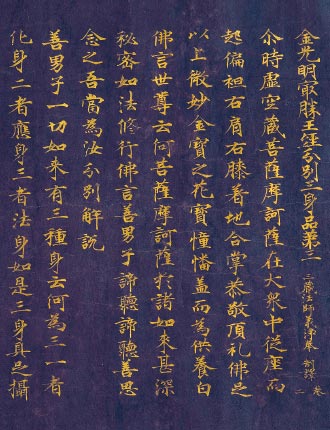
Long, long ago, an Indian prince named Siddhartha
went out from the gates of his castle and came upon a starving man, a sick
man, an old man, and finally a dying man. The prince, shocked to see men in
these conditions, asked, “Does poverty, illness, old age, and death come
upon only some people or upon all people?” Realizing that human beings
cannot escape such fate, Prince Siddhartha went on to seek a way to overcome
suffering and achieved enlightenment. His teachings today are known as
Buddhism.

Fragment of Scroll 4 of the Illustrated Ingakyō Sutra Nara period, 8th century
This scene depicts the historic Buddha Sakyamuni, dressed here as a monk, preaching to Zoroastrians.
This scene depicts the historic Buddha Sakyamuni, dressed here as a monk, preaching to Zoroastrians.

The words of Prince Siddhartha have
been passed down in Buddhist scriptures called sutras. These sacred
texts, which have been written over a period of more than 2,000 years,
are repositories of wisdom and stories.

In Japan, breathtakingly beautiful sutras on purple paper with gold lettering were created during the Nara period (710–794). What kinds of tales are told in these manuscripts? What did Emperor Shōmu who commissioned many scriptures think of these works? And what did the people of the time think? During the Heian period (794–1185), Fujiwara no Sadanobu (1088–1156) accomplished the tremendous feat of hand-copying more than 5,000 volumes of sutras over a period of twenty-three years. He also brushed characters enshrined in stupas with great speed and skill.
In Japan, breathtakingly beautiful sutras on purple paper with gold lettering were created during the Nara period (710–794). What kinds of tales are told in these manuscripts? What did Emperor Shōmu who commissioned many scriptures think of these works? And what did the people of the time think? During the Heian period (794–1185), Fujiwara no Sadanobu (1088–1156) accomplished the tremendous feat of hand-copying more than 5,000 volumes of sutras over a period of twenty-three years. He also brushed characters enshrined in stupas with great speed and skill.
Konkōmyō Sutra,
Scroll 2
(detail) Nara period, 8th century
This sutra was hand-copied with gold paint onto paper that was dyed dark purple. It is said that wild boar tusk was used to polish the gold letters to make them lustrous.
This sutra was hand-copied with gold paint onto paper that was dyed dark purple. It is said that wild boar tusk was used to polish the gold letters to make them lustrous.